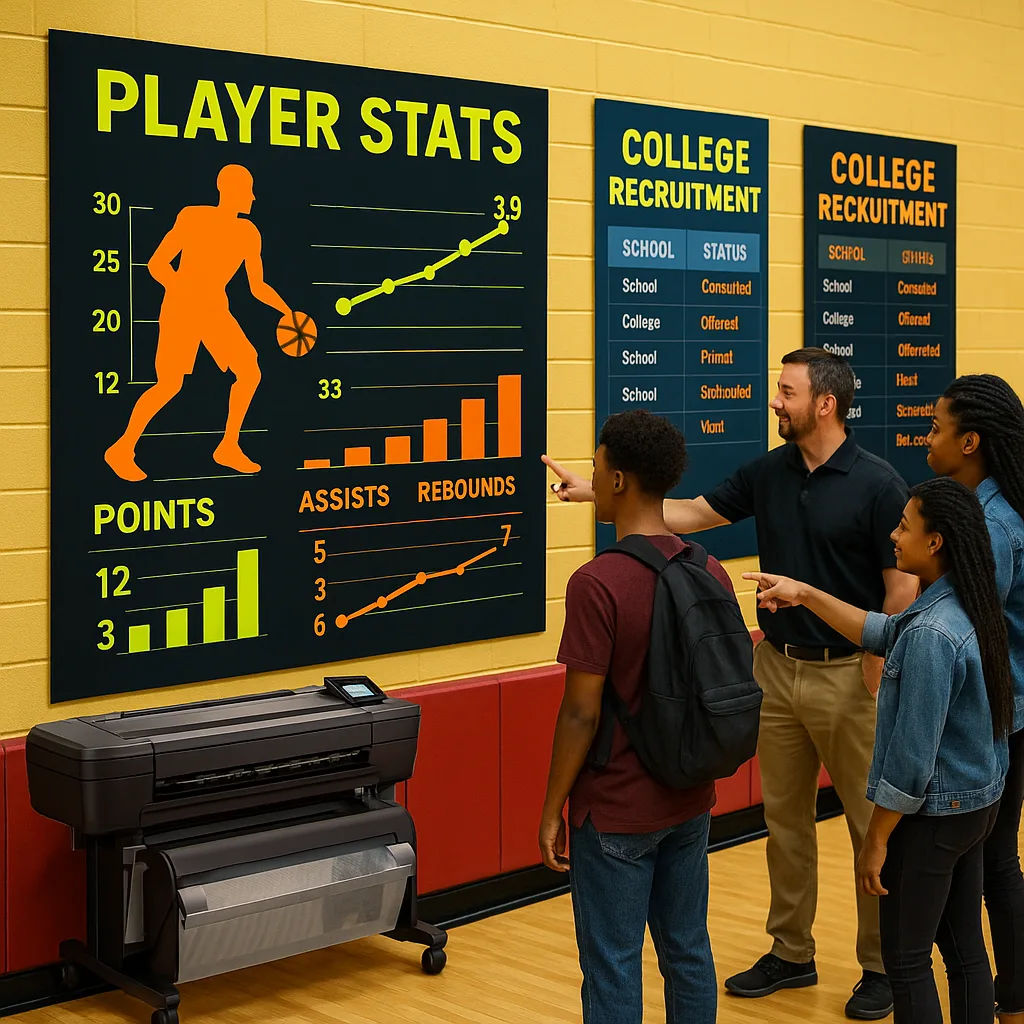
Picture this: students tracking seedling growth beneath vibrant, weather-resistant charts that sparkle with morning dew. These outdoor learning stations transform school gardens into living laboratories where science standards bloom alongside vegetables. With school poster printers for garden education, educators cultivate hands-on STEM experiences that endure through every season.
Why School Poster Printers for Garden Education Transform Outdoor Learning
Agricultural education has sprouted beyond traditional classroom walls. Today’s students dig deeper into science concepts through hands-on garden experiences. Yet, creating durable outdoor displays poses unique challenges. Standard paper wilts at the first raindrop, while expensive commercial signage strains already-tight budgets. This gap between need and reality often leaves garden-based programs relying on makeshift solutions that fade, peel, or blow away.
Enter the game-changing potential of weather-resistant printing technology. Modern Education Studio poster makers equipped with specialized inks and media transform how schools approach outdoor learning environments. These systems produce vibrant displays that withstand sun, rain, and temperature swings while maintaining educational clarity season after season.

Material Science Meets Educational Design
Successful outdoor displays begin with understanding material properties. Traditional paper-based posters absorb moisture, causing ink to run and substrates to disintegrate. However, specialized outdoor media resist water penetration while maintaining print quality. Vinyl substrates provide exceptional durability, while weatherproof synthetic papers offer a more eco-friendly alternative that still handles moisture exposure.
UV-resistant inks prevent the sun from stealing vibrancy from educational graphics. These pigment-based formulations maintain their educational impact through months of direct sunlight exposure. Additionally, lamination adds another protective layer, creating a barrier against physical damage from curious hands or garden tools.
Temperature fluctuations pose another challenge. Materials must expand and contract without cracking or warping. Quality outdoor media maintains dimensional stability from freezing winters to scorching summers, ensuring plant identification markers remain readable year-round.
Student engagement increases when using visual outdoor learning stations
Essential Components of Garden Education Displays
Plant Identification Markers
Durable markers featuring botanical names, care instructions, and QR codes linking to detailed informationDesign Specifications
Create 6″x4″ markers using weather-resistant vinyl. Include common name, scientific name, planting date, and care symbols. QR codes connect to student-created digital portfolios documenting growth progress.Growth Tracking Charts
Large-format charts allowing students to record observations directly on weatherproof surfacesImplementation Details
Design 24″x36″ charts with dry-erase lamination. Include measurement grids, weather tracking sections, and phenology wheels. Mount at student height for easy data collection during garden visits.Harvest Celebration Displays
Vibrant banners showcasing student achievements and connecting garden produce to nutrition educationCreative Applications
Produce seasonal banners highlighting harvest totals, recipes, and student reflections. Integrate math concepts through yield calculations and nutrition data visualization. Perfect for family engagement events.Instructional Signage
Step-by-step guides for garden tasks, tool safety reminders, and composting instructionsSafety & Learning
Create visual guides for proper tool use, hand-washing stations, and garden etiquette. Include both text and pictographs for pre-readers. Position at key locations throughout the garden space.Curriculum Alignment: Meeting Science Standards Through Garden Displays
Garden education displays serve as powerful tools for meeting Next Generation Science Standards (NGSS) and state-specific requirements. Visual learning stations support three-dimensional science learning by combining disciplinary core ideas with crosscutting concepts and science practices. A teacher poster maker enables educators to create standards-aligned materials that bring abstract concepts to life.
Life science standards come alive through plant lifecycle diagrams posted directly in growing areas. Students observe real specimens while referencing professionally printed guides showing germination, growth, flowering, and seed production stages. These displays incorporate scientific vocabulary and visual representations that support diverse learning styles.
Earth science connections emerge through weather monitoring stations featuring custom-printed data collection sheets. Students track precipitation, temperature, and seasonal changes using weatherproof charts that survive outdoor conditions. This hands-on data collection directly supports standards related to weather patterns and climate.

Advanced Weather-Resistant Solutions
For schools seeking maximum durability, latex printing technology offers revolutionary outdoor display capabilities. The HP Latex 800 Printer produces completely weatherproof graphics that withstand years of outdoor exposure without fading or deteriorating. These eco-friendly printers use water-based latex inks that cure instantly, creating scratch-resistant displays perfect for high-traffic garden areas.
Latex technology excels at producing vibrant colors on flexible materials like outdoor banner vinyl and adhesive-backed substrates. Schools can create everything from ground-level pathway markers to overhead shade structure graphics. The odorless printing process makes these systems ideal for indoor use while producing outdoor-ready materials.
Practical Implementation Strategies
Start small with essential signage before expanding your outdoor display system. Begin with plant identification markers and safety signs, then gradually add growth charts and celebration displays. This phased approach prevents overwhelming staff while building expertise.
Design templates during winter months when garden activity slows. Create reusable layouts that only require updating specific information each season. Store digital files organized by garden zone and plant type for quick access.
Material Selection Guidelines
Choose materials based on specific display locations and expected lifespan. For permanent installations like tool shed instructions, invest in rigid substrates with UV-protective lamination. Seasonal displays work well with lighter-weight materials that still resist moisture.
Consider these proven combinations: • Plant markers: 10mil vinyl with matte lamination • Growth charts: Synthetic paper with dry-erase laminate • Celebration banners: 13oz banner vinyl with reinforced hems • Pathway signs: Adhesive floor vinyl with slip-resistant overlaminate
Each material choice balances durability requirements with budget considerations. The cost per print remains surprisingly affordable when factoring in multi-year usage.
Ready to Transform Your School Garden?
Join thousands of educators creating weather-resistant learning environments with professional-grade printing solutions. Our team helps you select the perfect system for your garden education program.
Supporting Resources and Professional Development
Successful garden display programs thrive with proper support systems. Lifetime design assistance ensures educators never face creative blocks when developing new materials. Professional designers understand educational objectives and translate curriculum goals into visually engaging displays that capture student attention while conveying essential information.
Training opportunities help staff maximize their investment in printing technology. Live demonstrations showcase material handling techniques, design software features, and maintenance procedures. Ongoing support through phone consultations and screen-sharing sessions addresses challenges as they arise. This comprehensive approach transforms tentative users into confident creators of outdoor educational materials.
Community collaboration amplifies garden education impact. Share successful display designs with neighboring schools through template exchanges. Document seasonal changes with photo portfolios showing how displays weather over time. These real-world examples inspire creative solutions while building networks of garden educators supporting each other’s programs.







